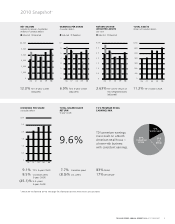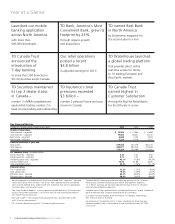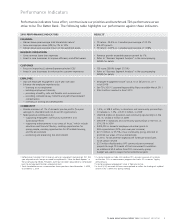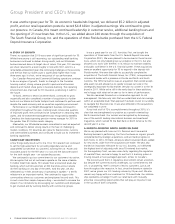TD Bank 2010 Annual Report Download - page 13
Download and view the complete annual report
Please find page 13 of the 2010 TD Bank annual report below. You can navigate through the pages in the report by either clicking on the pages listed below, or by using the keyword search tool below to find specific information within the annual report.
TD BANK GROUP ANNUAL REPORT 2010 MANAGEMENT’S DISCUSSION AND ANALYSIS 11
Reconciliation of Reported Earnings per Share (EPS) to Adjusted EPS1
(Canadian dollars) 2010 2009 2008
Diluted − reported $ 5.10 $ 3.47 $ 4.87
Items of note affecting income (as above) 0.67 1.88 (0.03)
Items of note affecting EPS only2 – – 0.04
Diluted − adjusted $ 5.77 $ 5.35 $ 4.88
Basic − reported $ 5.13 $ 3.49 $ 4.90
insurance claims was challenged and held to be unconstitutional. During 2009,
the government of Alberta won its appeal of the decision. The plaintiffs sought
leave to appeal the decision to the Supreme Court of Canada and in 2010, the
Supreme Court of Canada denied the plaintiffs’ application to seek leave to
appeal. As a result of this favourable outcome, the Bank released its provision
related to the minor injury cap litigation in Alberta.
13
Effective November 1, 2009, TD Financing Services (formerly VFC Inc.) aligned
their loan loss methodology with that used for all other Canadian Personal and
Commercial Banking retail loans; any general provisions resulting from the revised
methodology are included in “General allowance increase in Canadian Personal
and Commercial Banking and Wholesale Banking.”
14
Upon the announcement of the privatization of TD Banknorth in November 2006,
certain minority shareholders of TD Banknorth initiated class action litigation alleging
1
EPS is computed by dividing net income available to common shareholders by the
weighted-average number of shares outstanding during the period.
various claims against the Bank, TD Banknorth, and TD Banknorth officers and
directors (TD Banknorth Shareholders’ Litigation). The parties agreed to settle the
litigation in February 2009 for $61.3 million (US$50 million) of which $3.7 million
(US$3 million) had been previously accrued on privatization. The Court of Chancery
in Delaware approved the settlement of the TD Banknorth Shareholders’ Litigation
effective June 24, 2009, and the settlement became final. The net after-tax impact
of the settlement was $39 million.
15
On May 22, 2009, the FDIC, in the U.S., finalized a special assessment resulting in
a charge of $55 million before tax or US$49 million before tax.
16
The Bank resolved several outstanding tax matters related to Wholesale Banking
strategies that have been previously reassessed by the Canada Revenue Agency
(CRA) and that were awaiting resolution by the CRA appeals division or the courts.
The Bank no longer enters into these types of strategies.
2
The diluted earnings per share figures do not include Commerce earnings for the
month of April 2008 because there was a one month lag between fiscal quarter
ends until the first quarter of 2009, while share issuance on close resulted in a
one-time negative earnings impact of four cents per share.
(millions of Canadian dollars) 2010 2009 2008
Canada Trust $ 159 $ 159 $ 143
TD Bank, N.A. 200 257 170
TD Ameritrade (included in equity in net income of associated company) 72 68 66
Other 36 8 25
Total $ 467 $ 492 $ 404
1
Amortization of intangibles is included in the Corporate segment.
(millions of Canadian dollars) 2010 2009 2008
Average common equity $ 36,639 $ 35,341 $ 26,213
Average cumulative goodwill/intangible assets amortized, net of income taxes 4,943 4,541 4,136
Average invested capital $ 41,582 $ 39,882 $ 30,349
Rate charged for invested capital 10.0% 10.0% 9.3%
Charge for invested capital $ 4,158 $ 3,988 $ 2,822
Net income available to common shareholders – reported $ 4,450 $ 2,953 $ 3,774
Items of note impacting income, net of income taxes 584 1,596 (20)
Net income available to common shareholders – adjusted $ 5,034 $ 4,549 $ 3,754
Economic profit $ 876 $ 561 $ 932
Return on invested capital 12.1% 11.4% 12.4%
AMORTIZATION OF INTANGIBLES, NET OF INCOME TAXES1
TABLE 3
ECONOMIC PROFIT AND RETURN ON INVESTED CAPITAL
The Bank utilizes economic profit as a tool to measure shareholder
value creation. Economic profit is adjusted net income available to
common shareholders less a charge for average invested capital. Aver-
age invested capital is equal to average common equity for the period
plus the average cumulative after-tax goodwill and intangible assets
amortized as of the reporting date. The rate used in the charge for
capital is the equity cost of capital calculated using the capital asset
pricing model. The charge represents an assumed minimum return
required by common shareholders on the Bank’s invested capital. The
Bank’s goal is to achieve positive and growing economic profit.
Return on invested capital (ROIC) is adjusted net income available to
common shareholders divided by average invested capital. ROIC is a
variation of the economic profit measure that is useful in comparison
to the equity cost of capital. Both ROIC and the equity cost of capital
are percentage rates, while economic profit is a dollar measure. When
ROIC exceeds the equity cost of capital, economic profit is positive. The
Bank’s goal is to maximize economic profit by achieving ROIC that
exceeds the equity cost of capital.
Economic profit and ROIC are non-GAAP financial measures as these
are not defined terms under GAAP. Readers are cautioned that earnings
and other measures adjusted to a basis other than GAAP do not have
standardized meanings under GAAP and, therefore, may not be compa-
rable
to similar terms used by other issuers.
The following table reconciles between the Bank’s economic profit,
ROIC, and adjusted net income available to common shareholders.
Adjusted results, items of note, and related terms are discussed in the
”How the Bank Reports” section.
RECONCILIATION OF NET INCOME AVAILABLE TO COMMON SHAREHOLDERS − ADJUSTED, ECONOMIC PROFIT,
AND RETURN ON INVESTED CAPITAL
TABLE 4
























